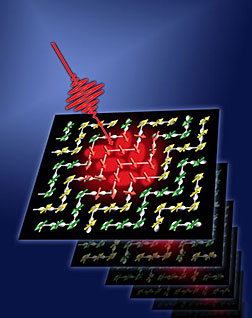- Number 389 |
- May 27, 2013
Quantum tricks drive magnetic switching into the fast lane

Magnetic structure in a colossal magneto-
resistive manganite is switched from
antiferromagnetic to ferromagnetic ordering
during about 100 femtosecond (10-15 s)
laser pulse photo-excitation. With time so
short and the laser pulses still interacting
with magnetic moments, the magnetic
switching is driven quantum mechanically –
not thermally. This potentially opens the door
to terahertz (1012 hertz) and faster memory
writing/reading speeds.
Researchers at DOE’s Ames Laboratory, Iowa State University, and the University of Crete in Greece have found a new way to switch magnetism that is at least 1000 times faster than currently used in magnetic memory technologies. Magnetic switching is used to encode information in hard drives, magnetic random access memory and other computing devices. The discovery potentially opens the door to terahertz and faster memory speeds.
Ames Laboratory physicist Jigang Wang and his team used short laser pulses to create ultra-fast changes in the magnetic structure, within quadrillionths of a second (femtosecond), from anti-ferromagnetic to ferromagnetic ordering in colossal magnetoresistive materials, which are promising for use in next-generation memory and logic devices.
Full story: https://www.ameslab.gov/news/news-releases/quantum-tricks-drive-magnetic-switching-fast-lane.[Breehan Gerleman Lucchesi, 515.294.9750,
breehan@ameslab.gov]
